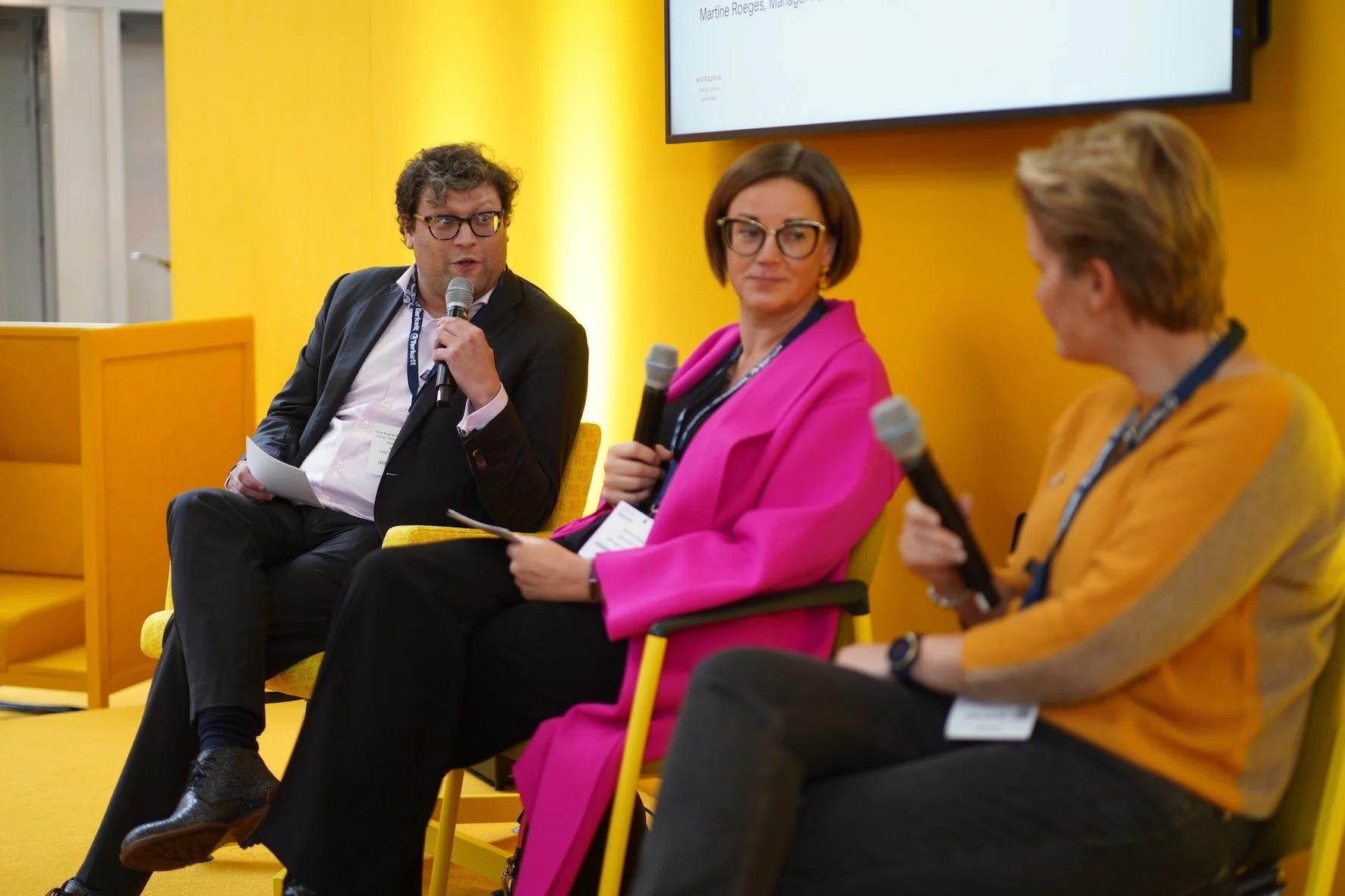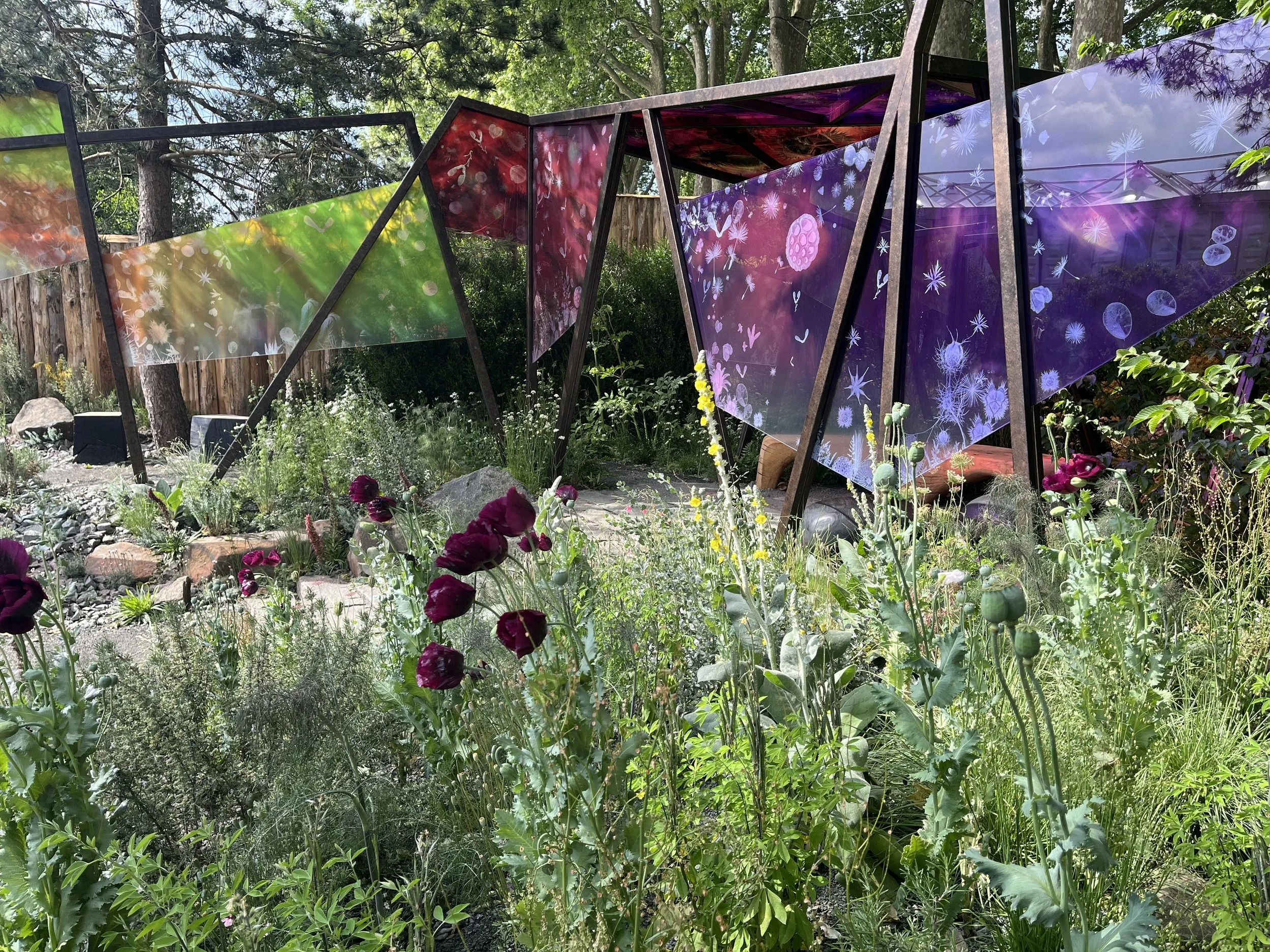The Journal of Biophilic Design is proud to be one of 60+ industry-leading organisations, including UK Green Building Council (UKGBC), RIBA, ASBP - Alliance for Sustainable Building Products, and UK Architects Declare, supporting Futurebuild 2026. These influential bodies and associations play an integral role in the Futurebuild Knowledge Programme, delivering 133 hours of CPD-accredited content over 3 days across two conferences and multiple seminar stages.
Futurebuild is the platform where content is curated by the industry for the industry. Immerse yourself in three days of ideas, inspiration, topical discussions and debates on:
Improving design & safety
Tackling rising costs
Meeting ambitious sustainability goals
Find out more and register free CLICK HERE
Workspace Design Show Amsterdam opens 5-6 November 2025
Workspace Design Show (5–6 November 2025, Hall 5, RAI Amsterdam) is set to welcome thousands of workplace professionals next week including architects, designers, and occupiers from across Europe.
This year’s edition invites visitors to “Activate their Senses”, turning every corner of Hall 5 into a vibrant, multi-sensory exploration of how design can transform the way we work, feel, and connect…. READ on
A not quite fatal world
Who would want to live in a world that is not quite fatal?
So said ecologist Paul Shepherd in 1958, and quoted by Rachel Carson in “Silent Spring”.
The Biophilic Design Conference this year has a theme of Policy, Place, Planet – Biophilic Design for a regenerative future. It has this theme for a reason.
We are living in a ticking time bomb. Our planet is heating up, our climates are changing all over the world, our food security is at risk, our physical health is challenged not just by lifestyle and town planning but also by air and sound pollution inside and outside of the home and workplace, our crops are sprayed, our bees are dying, we are losing our pollinators, our skies are quieter, our living world is struggling to breathe and we are the culprits.
When I first learnt about Biophilic Design, it seemed to me a concept which if applied globally and on all facets of society we could go some way to reverse the ills we have inflicted onto ourselves and our planet.
READ ON…
Workspace Design Awards - Open Sept 1 2025
Workspace Design Show (25 – 26 February 2026, Business Design Centre, London)announces the launch of the Workspace Design Awards, a brand-new awards programme dedicated exclusively to celebrating outstanding workplace design and its impact on business. The 2026 London edition of the Workspace Design Show will see the first awards take place on 25 February 2026, giving recognition to architectural innovation, user experience and creativity that is redefining how, where, and why we work.
A Night of Nature - September 6, 2025
The RSPB will host a unique live event, ‘A Night of Nature’, at London’s Troxy on September 6, 2025. An audiovisual celebration of the natural world which is open to all, the one-off experience will blend cinema with the immediacy of a concert, thanks to live music synched to stunning footage of natural habitats and species, performed by multi-million selling vocal group (and X Factor finalists) G4 and the Vesper String Quartet.
How to Grow a House – Royal Institution Lecture June 2025
We talk about living buildings but what if a building could really be “alive”?
I attended a fascinating presentation of research at the Royal Institution, Professor Martyn Dade-Robertson revealed a future where buildings aren't just constructed—they're grown. Imagine foundations that heal themselves, walls that breathe, and roofs that respond to sunlight, all created by microscopic organisms working in harmony.
Robertson's research shows how bacteria can literally strengthen the ground beneath our feet. By introducing specially engineered microbes into soil, these tiny organisms can produce calcium carbonate crystals that bind soil particles together, creating foundations more resilient than traditional concrete methods.
Mycelium, the root network of mushrooms, is continually being celebrated as a revolutionary material for insulation, packaging, alternatives to plastics, but now, in experiments with NASA, Robertson's team have demonstrated how this fungal network could potentially create structures on Mars, growing insulation and structural components in resource-limited environments. A full-scale mycelium structure built in New York completely biodegraded within just four months of being dismantled.
The most fascinating aspect is the materials' ability to self-heal. Mycelium can "biologically weld" itself, fusing broken components back together. Bacterial cellulose can create surfaces that respond to light, changing colour like living skin—imagine walls that tan in sunlight or tiles that darken to provide shade.
These aren't just theoretical concepts. Robertson's team has already explored the waterproof nature of mushrooms. Hydrophobins are proteins which play a crucial role in mycelium's hydrophobicity (waterproofness!). They self-assemble at air-water interfaces, creating a hydrophobic layer on the surface of the mycelium. So the scientists have researched this hydrophobic behaviour and have tested coatings derived from bacterial proteins that can protect materials and make them fire-resistant. One experiment showed a piece of balsa wood treated with their protein coating survived a fire that would have quickly consumed an untreated piece.
READ ON…
Biophilic Design and Plastic Free July
Biophilic Design helps us combat the plastic pollution. The Biophilia hypothesis helps decisions which are better for our planet and us.
Join millions of people reducing their plastic waste.
Plastic Free July™ is a global movement that helps millions of people be part of the solution to plastic pollution – so we can have cleaner streets, oceans, and beautiful communities. If you are implementing Biophilic Design as close as possible as you can to the original principles you will already have taken HUGE steps towards combatting how much plastic is in our environment. So thank you. Please encourage as many other designers as you can to look at the principles of Biophilic Design.
Light that Nourishes
To coincide with the publication of Issue 15 of The Light issue of the Journal of Biophilic Design, light aficionado Xander Cadisch writes.
We live bathed in an ocean of light, yet rarely consider how its invisible waves shape our very biology. Modern research reveals what ancient healers intuited—that light isn't just something we see, but a vital nutrient that regulates our cells, hormones, and nervous system. The implications for how we design our spaces are profound.
At the heart of this revelation lies a simple truth: different colours of light act as distinct biological signals. Take red light, for instance. With wavelengths between 630-700 nanometres, it penetrates deep into our tissues, stimulating mitochondria—those tiny power plants within our cells. This isn't speculative science, it's therapy approved by regulatory bodies like the FDA, now used to accelerate wound healing and ease arthritis pain. Hospitals are beginning to harness this knowledge, installing red light panels in recovery rooms where patients benefit from its regenerative properties.
Read on….
Designs with Distinction - Workspace Design Awards to Launch at the 2026 London Edition of Workspace Design Show!
Workspace Design Show (25 – 26 February 2026, Business Design Centre, London)announces the launch of the Workspace Design Awards, a brand-new awards programme dedicated exclusively to celebrating outstanding workplace design and its impact on business. The 2026 London edition of the Workspace Design Show will see the first awards take place on 25 February 2026, giving recognition to architectural innovation, user experience and creativity that is redefining how, where, and why we work.
Workspace Design Show is a must-attend event for the commercial interiors community and this new awards programme expands the Workspace Design Show offering, creating a new platform to honour both completed workplace projects and visionary designs.
What sets the Workspace Design Awards apart is its commitment to real end user impact and evaluation, as such the judging panel will be exclusively composed of corporate occupiers, developers, and project management firms, bringing a rounded assessment of entries. Judges include, Steve Wright, Director of Workplace Design & Change Management, GSK, Helena Hughes, Director, Global Occupier Services, Savills, James Stratford, Head of Workplace, AXA XL, Sarah Audsley, Partner, Knight Frank and others.
The awards ceremony will be hosted by Alys Bryan, Editor, Design Insider and Anna King, CEO and Founder, Informare and will be held in a beautifully designed feature space within the show, brought to life by leading architects and designers. Guests can expect an evening of celebration, complete with drinks, canapés, and a lively atmosphere, coupled with the opportunity to connect with the industry.
READ ON and ENTER THE AWARDS
Biophilic influence from the 2025 RHS Chelsea Flower Show
Biophilic influence from the 2025 RHS Chelsea Flower Show Something that could be perceived as outdated, yet still prevails, is that many people visit the prestigious RHS Chelsea Flower Show expecting to be wowed by the grandness of the gardens, much like they were in days of old; when the big corporates sponsored designers to build extravagant, potentially unachievable (to us mortals) works of art, with very little thought around the environmental impact of materials used, construction methods and certainly not a whisper of sustainability - gasp, what even is that? Thankfully, the tide has truly turned and we now see more focus on what is going on behind the scenes with an insistence on rehoming the gardens and a strong encouragement on using sustainable materials, planning clever water capture methods and building with minimal ground disturbance. This year, it was also wonderful to see so many of the planting schemes blending foraging, feeding and biodiversity needs, using companion planting and showing an in-depth knowledge of ecosystems, thus demonstrating how we as mere consumers can future-proof our own green spaces. I felt visitors were given renewed confidence that experimenting is actually okay, and gained vital inspiration in ways to interact with their own garden. READ ON….
New Care Innovation Summit to Launch in June 2025
For us Biophilic Design is ESSENTIAL for third age design. Check out the interview we did with Lori Pinkerton-Rolet, one of the leading names in older care interior design, and someone every Biophilic Desiner should follow. Lori is speaking at the new Care Innovation Summit, taking place on 19 June 2025 at the Business Design Centre, London.
Though new in name, the event will feel familiar to many. It brings together two of the sector’s most respected conferences - The Future of Care Leaders Conference and Dementia Summit - organised by Broadway Events, a leading name in care sector events since 2011. In response to the growing number of industry events, Broadway Events has streamlined its offering, merging these flagship events into a single three-stream conference, making it easier than ever for care professionals to access key insights in one place.
Alongside dedicated content on the Future of Care and Dementia Care, the event introduces a Healthcare Design & Build stream, bringing together decision-makers, innovators and frontline professionals to explore the future of care, its challenges and its opportunities.
READ ON AND BOOK TICKETS
SURFACING BRANDS WITH SOUL - a report on the Surface Design Show 2024
Get your jazz hands ready and lets celebrate sustainable design. Surface - the annual design showthat takes place in London’s Design hub in Islington each February, was a vibrant showcase ofbrands - international, as well as domestic, being creative in their mission to help our planet.
As Nickie West, Managing Director of Surface Design Show explains: "The theme for 2024focuses on the ambition to design well while doing good – with a conscious effort to protect our planet by aiming for zero waste manufactures and sustainable alternatives.
The natural world remains a key influence on the design industry, inspiring new techniques andprocesses, as well as offering a wealth of material substitutes."
Futurebuild 4 -6 March 2025 London ExCeL
Join Futurebuild from 04 – 06 March 2025 at London’s ExCeL, the most impactful event in sustainable innovation for the built environment. Discover the latest products, solutions, and insights that will help you achieve your sustainability goals and drive meaningful change.
As Futurebuild celebrates its 20th anniversary, the theme for 2025 is Impact—marking two decades of driving positive change in the built environment and the communities we serve. Be part of this milestone event and contribute to shaping a more sustainable future. Register nowfor your free ticket.
Surface Design Show 4- 6 February 2025, London
Chatham House Climate and Energy Summit 18-19 March 2025
On the road to COP30, join governments and businesses for two days of interactive discussion exploring strategies to secure a resilient future. Two days of high-level panel dialogues, networking sessions and an interactive workshop under the Chatham House Rule will focus on multi-stakeholder collaboration for increased ambition, action and impact.
Join us!
Chatham House Climate and Energy Summit
18-19 March 2025 | In-person and broadcast live
Designing Healthy, Sustainable BIOPHILIC Buildings for the Future
As the climate crisis and mental health challenges collide, the built environment has a crucial role to play in supporting human wellbeing. In a wide-ranging discussion, hosted at Anticipate London, and chaired by Dr Vanessa Champion, founder and editor of the Journal of Biophilic Design, experts from the fields of architecture, sustainability, and design explored how green buildings can nurture both physical and mental health. Watch the discussion with Rob Buckley, Head of Sustainability at QODA Consulting, Astrid Hugo, Senior Sustainability Specialist, at Gensler and Anthony Thistleton-Smith, Co-Founder of Waugh Thistleton Architects.
Earth Day - more reasons why we need Biophilic Designers in every sector…
EARTHDAY.ORG, the global leader in Earth Day advocacy, observed by over one billion people each April 22, is excited to announce the launch of a new campaign inviting business leaders worldwide to champion climate education in schools, colleges, and vocational training programs across the globe.
More reasons why we need Biophilic Designers in every sector….
The inaugural Biophilic Design Conference 2024
London’s iconic Barbican conservatory couldn’t have been more fitting for a conference dedicated to the immense benefits of a world designed with biophilic principles. Visionaries, designers, architects, lawyers, academics, entrepreneurs, advocates and professionals across various walks in life, came together to share their perspectives for one full day in a series of talks.
Biophilic Desining Enhancing Wellbeing - Part 1
This was part 1 of an interview with Jeffrey Hart of the Building Sustainability Podcast. Tables were turned and he was interviewing our founder, Vanessa Champion.
In this episode, guest Vanessa Champion discusses biophilia and biophilic design, emphasizing the importance of nature connection and its benefits for well-being and the environment. We explore underappreciated biophilic patterns, healthcare benefits, materials, and so much more.
Overall, the focus is on improving the built environment for people and the planet through biophilic design.
Part 1!
Biophilic Design Enhancing Wellbeing - Part 2
I really enjoyed this discussion with the lovely Jeffrey Hart, this is Part 2.
In this episode, we explors the fascinating world of biophilic design and its potential impact on sustainable and ethical practices. We delve into the use of clay, earth materials, and mushroom mycelium as tactile and eco-friendly alternatives. The episode also touches upon the challenges of promoting green alternatives in mainstream industries and the potential positive effects of biophilic design on employee ethics and productivity.
Lastly, Vanessa highlights the growing popularity of biophilic design and its numerous benefits, from improved air quality to increased real estate value.
Tune in for an intriguing discussion on incorporating nature into indoor spaces for a more sustainable and enjoyable environment.
Building Sustainability Podcast (Part 2!)



















